Cookware for Camping - An Ultimate Guide
Discover the best camping cookware with expert tips, top products, and FAQs to elevate your outdoor cooking experience for any adventure.
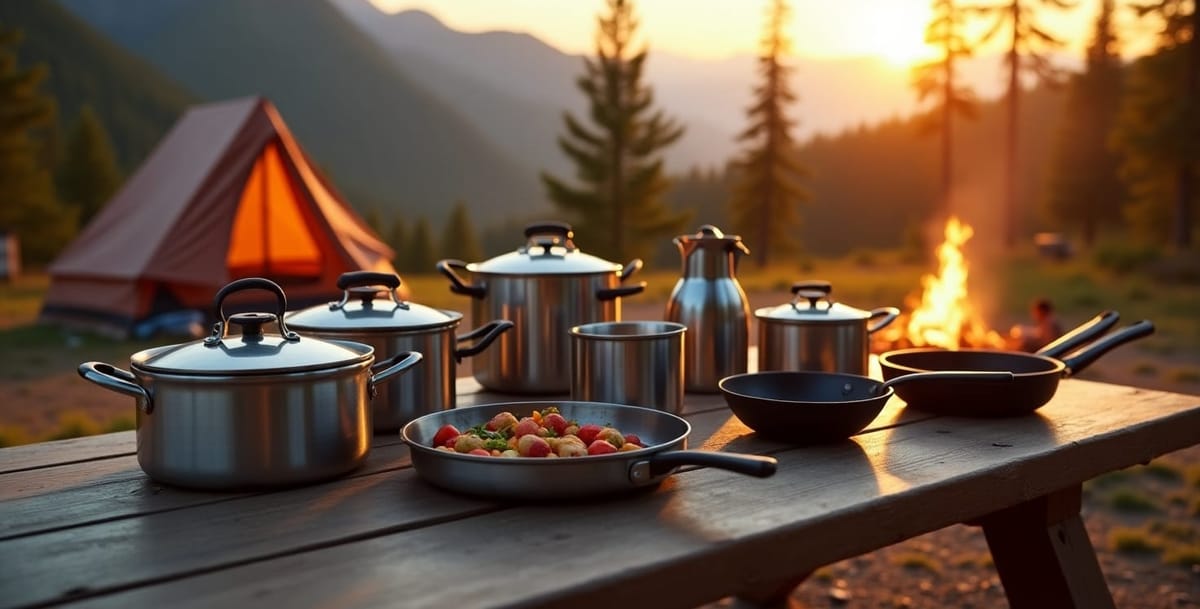
Camping cookware is the cornerstone of any successful outdoor culinary experience, balancing portability, durability, and functionality. The right set can transform campfire meals from basic sustenance into gourmet adventures, while the wrong choice may lead to frustration, uneven cooking, or even equipment failure.
This guide synthesizes insights from leading gear testers, material scientists, and outdoor enthusiasts to help you navigate the complex landscape of camping cookware.
Key considerations include material composition (with titanium emerging as a premium ultralight option), heat distribution properties, and multi-functionality for diverse cooking techniques. Recent advancements in ceramic coatings and nesting designs have expanded possibilities for backpackers and car campers, offering solutions tailored to specific needs like group feeding or solo expeditions.
Buyer’s Guide
How to Find the Best Cookware For Camping
Material Matters: Balancing Weight and Performance
The foundation of any camping cookware selection lies in material choice, which directly impacts weight, heat conductivity, and durability.
Aluminum remains popular for its excellent heat conduction and affordability, though it’s prone to hot spots and can react with acidic foods.
Anodized aluminum solves reactivity issues through electrochemical treatment, creating a harder surface that resists corrosion—ideal for frequent tomato-based dishes or citrus marinades.
Titanium dominates the ultralight market, with sets like the Sea to Summit Alpha 1.1 weighing mere ounces, though its poor heat distribution requires careful flame management.
Cast iron, exemplified by the Lodge Dutch Oven Combo Cooker, offers unparalleled heat retention for slow-cooked stews and bread baking, despite its prohibitive weight for backpacking.
Weight-to-Durability Ratio
Backpackers prioritizing weight savings often opt for titanium or thin-walled aluminum, where a 1.1L pot might weigh under 7 ounces. Car campers can indulge in heavier materials like stainless steel or cast iron. Recent innovations in hybrid designs combine non-stick ceramic interiors with aluminum cores to reduce weight while maintaining cooking performance.
Heat Distribution and Control
Material thickness significantly affects thermal properties. Thin titanium pots boil water rapidly but struggle with even heating for sautéing, while cast iron’s thermal mass makes it excellent for simmering but challenging to adjust temperature quickly.
Maintenance and Cleanability
Field maintenance demands differ sharply from home kitchens. Non-stick coatings like those on the MSR Fusion Ceramic simplify cleaning without running water but require careful utensil use to prevent scratching.
Cast iron needs thorough drying and oiling to prevent rust, making it better suited for car camping, where proper maintenance is feasible. Stainless steel options like the Stanley Adventure series offer dishwasher-safe convenience but may develop stubborn stains from prolonged use around campfires.
Top Picks
Odoland Camping Cookware Mess Kit
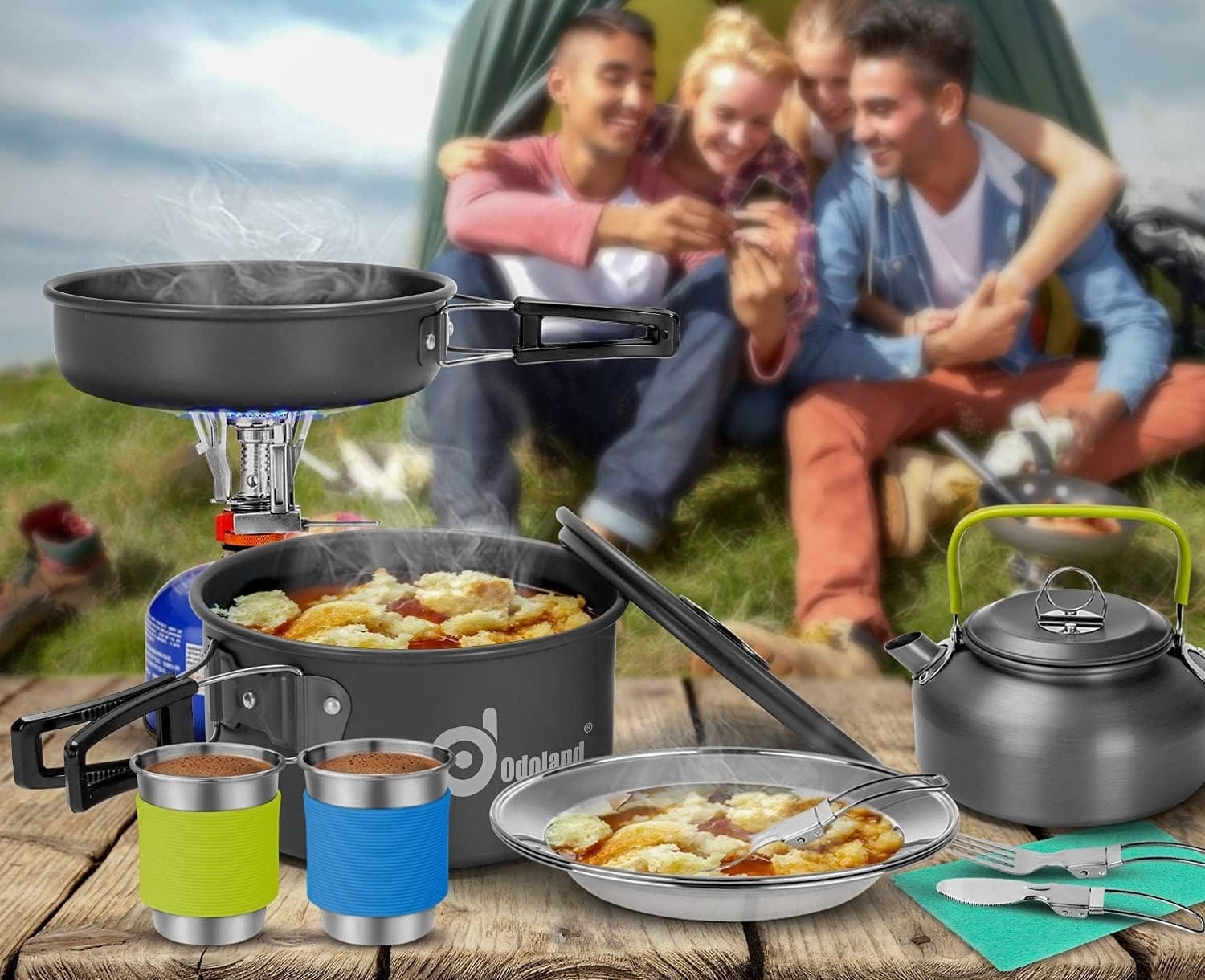
Pros:
- Comprehensive Set: Includes pots, pans, kettle, stainless steel cups, plates, and full utensils—everything needed for outdoor cooking in one kit.
- Lightweight and Compact: Designed for portability, the set nests together in a mesh bag, making it easy to pack for backpacking or camping trips.
- Affordable: Offers excellent value, especially for beginners or those on a budget, compared to more expensive branded kits.
- Non-Stick Coating: Pots and pans feature a non-stick surface for easier cooking and cleaning.
- Functional Stove: The included camping stove is durable and reliable, performing well in multiple user tests.
Cons:
- Durability Concerns: Some components, like the pot handles, utensil set, and gas canister attachment, feel flimsy and may break with rough use.
- Quality of Accessories: Stainless steel cups and foldable utensils are reported to be of low quality; utensils may rust or break, and the cup is often left behind by users.
- Brand Support: As a lesser-known brand, Odoland may have inconsistent quality control and limited customer support.
- Not Suited for Open Fire: The set is best for use with portable stoves rather than direct campfire cooking, as durability under high heat is limited.
Bottom Line from the Editor:
This Camping Cookware Mess Kit is an excellent budget-friendly choice for beginner campers or those seeking a lightweight, all-in-one solution. While it may not match the durability of premium brands, its comprehensive features and portability make it a practical starter kit for casual outdoor adventures—just handle with care and consider upgrading utensils for longer trips.
FORTITUDE21 Camping Cookware Set
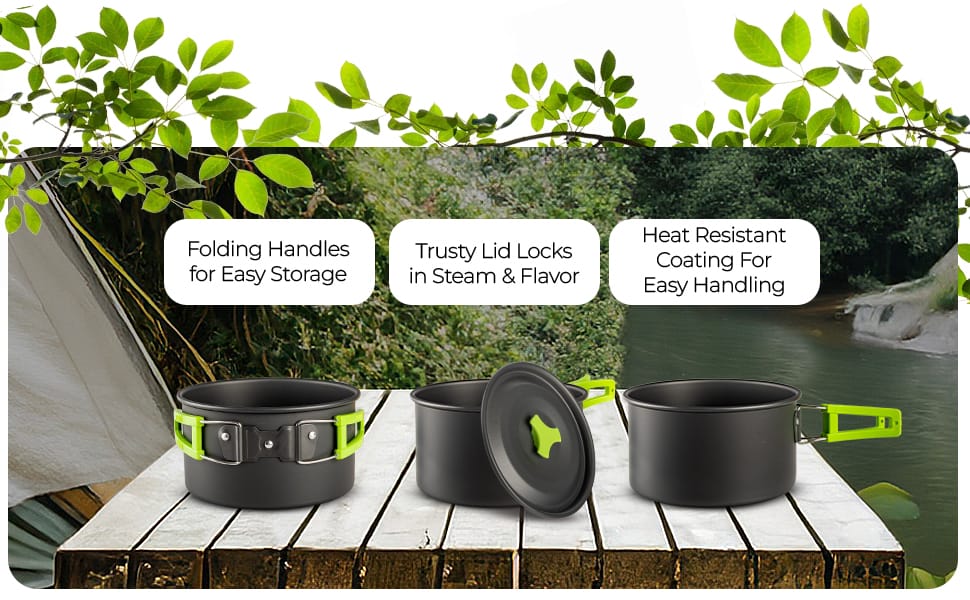
Pros:
- Comprehensive kit includes pots, pans, utensils, and accessories—ideal for beginners or anyone wanting an all-in-one solution.
- Lightweight and compact design makes it suitable for backpacking, hiking, and travel.
- Nesting components save space in your backpack and keep gear organized.
- Typically made from materials like anodized aluminum, which balances durability and weight.
- Affordable price point compared to premium brands, making it accessible for most campers.
Cons:
- Durability may not match higher-end or single-material cookware sets; some components can be prone to dents or wear over time.
- Non-stick coatings, if present, can scratch easily and may not withstand metal utensils or open flame cooking.
- Smaller pot and pan sizes may be limiting for group cooking or more elaborate camp meals.
- Basic utensils may feel flimsy compared to standalone camping cutlery.
- Some users report uneven heat distribution, which can lead to hot spots or burning food if not monitored closely.
Editor’s Bottom Line:
This Camping Cookware Set is a practical and budget-friendly starter kit for solo campers or small groups who value portability and convenience.
While it may not offer the long-term durability or advanced cooking performance of premium sets, its compact design and all-in-one approach make it a solid choice for occasional camping, hiking, or emergency preparedness. For frequent campers or those seeking gourmet camp meals, investing in a higher-quality set may be worthwhile.
Stanley Wildfare Core 26-Piece Complete Camp Set
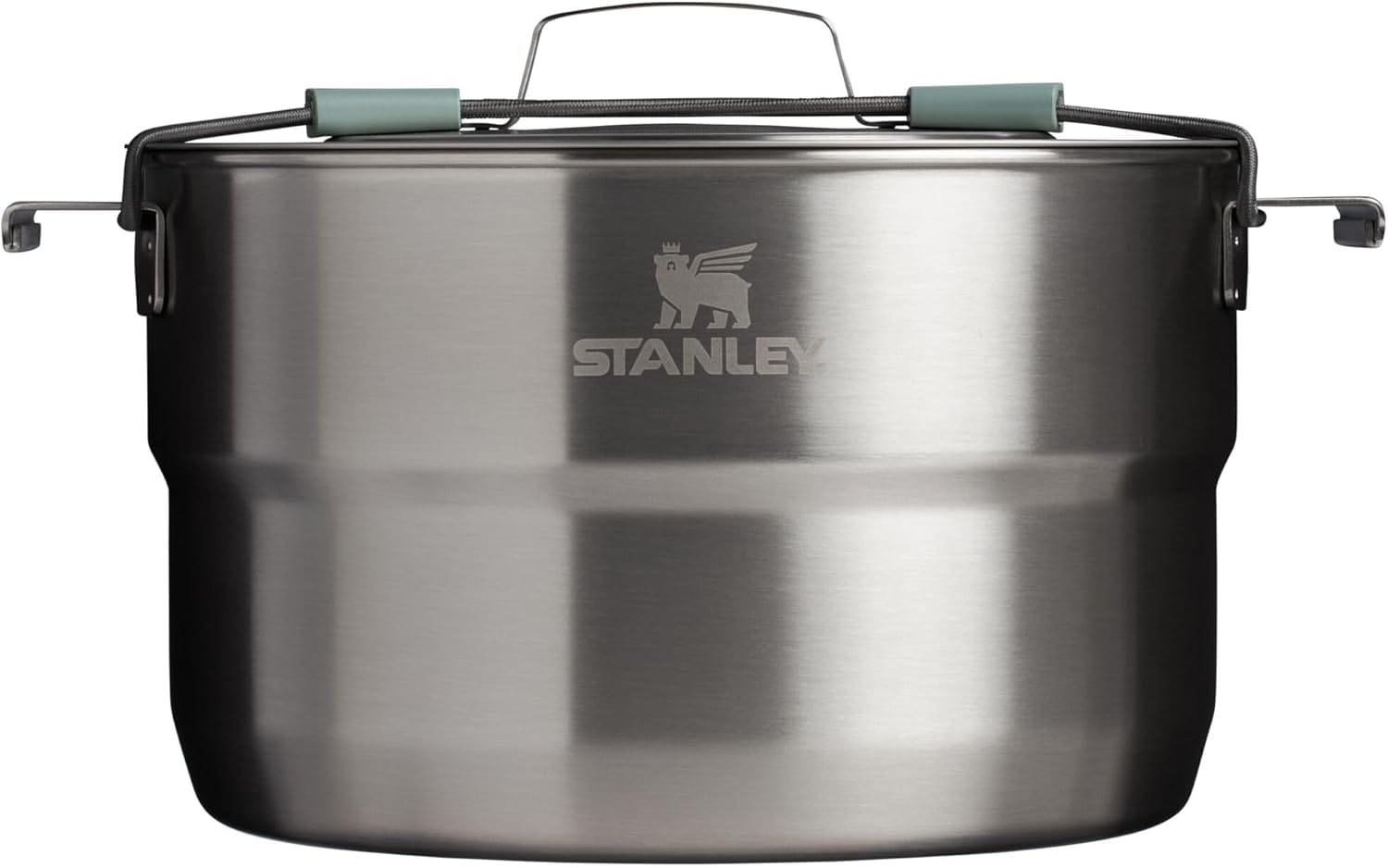
Pros:
- Comprehensive All-in-One Kit: Includes a 4-quart stainless steel pot, 8-inch tri-ply fry pan, vented lid, nonslip cutting board with removable trivet, plates, bowls, dual-end cutlery, spatulas, and serving spoons—enough for four people.
- Durable Construction: Made from 18/8 food-grade stainless steel, ensuring long-term durability and resistance to rust and corrosion.
- Induction Compatible: Works on a variety of heat sources, including induction stoves, making it versatile for different camping setups.
- Thoughtful Design: Features such as nesting components, fold & lock handles, a bungee closure, and a compact, portable form factor make packing and transport easy.
- Dishwasher Safe: Easy to clean at home after your trip.
- Multi-Functional Accessories: The included cutting board doubles as a trivet, and the lid has vent and strain holes for added convenience.
Cons:
- Weight: At over 7 pounds, this set is heavy for backpacking and better suited for car camping or group outings.
- Plastic Tableware: While lightweight, the plastic plates and bowls may scratch over time and are less durable than metal alternatives.
- Price: As a premium, all-in-one kit, it’s more expensive than basic cookware sets, which may be overkill for solo campers or minimalists.
- Bulk: The complete set, even when nested, takes up more space than minimalist or solo kits.
Editor’s Bottom Line:
The Stanley Wildfare Core 26-Piece Complete Camp Set is a thoughtfully designed, ultra-durable kitchen-in-a-box that’s perfect for families or groups who want to cook and dine comfortably at the campsite.
Its robust stainless steel construction and comprehensive accessory suite justify the investment for car campers and outdoor hosts. However, its weight and bulk make it less ideal for backpackers or solo adventurers. If you want a reliable, all-in-one solution for group camping meals, this set is a top contender.
MalloMe Camping Cookware Mess Kit for Backpacking Gear
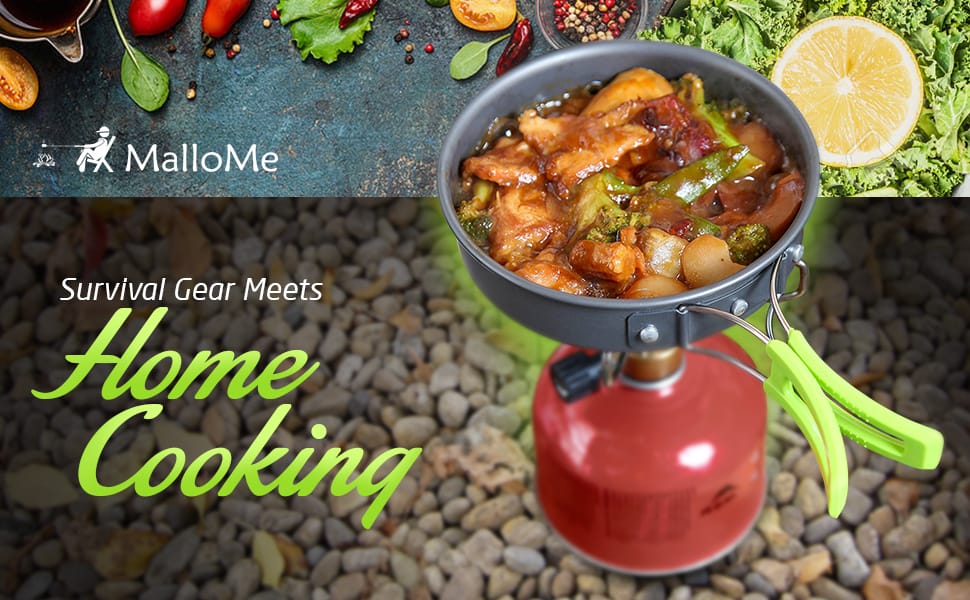
Pros:
- Lightweight and compact design makes it easy to pack and transport, ideal for backpackers and solo campers.
- Made from non-toxic, anodized aluminum, offering quick heat conduction and decent durability for the price.
- Includes a comprehensive set of accessories: pot, pan, bowls, spork, ladle, wooden spatula, cleaning sponge, and a carrying bag—great value for beginners or those starting from scratch.
- Easy to clean and nest together for efficient storage.
- Affordable price point, making it accessible for budget-conscious campers.
Cons:
- The included bowls and cups are quite small, which may not suit adults with larger appetites or those needing bigger portions.
- Some accessory items, like the folding spork, feel flimsy and may not withstand heavy use.
- The skillet is thin, prone to hotspots, and can burn food easily, making it less ideal for complex camp meals.
- Not as durable as higher-end stainless steel kits; the pot and pan can scratch if used with metal utensils.
- Best suited for one person; not practical for group cooking or larger meals.
Editor’s Bottom Line:
The MalloMe Camping Cookware Mess Kit stands out for its lightweight, compact build and excellent value, making it a smart pick for casual campers, backpackers, or anyone just starting their outdoor cooking journey.
While it’s not the most robust or spacious set on the market, its affordability and all-in-one convenience make it a reliable companion for solo adventures or quick weekend trips. If you need a basic, portable kit and don’t mind smaller portions, the MalloMe is a practical choice for your next camping outing.
CAROTE Pots and Pans Set
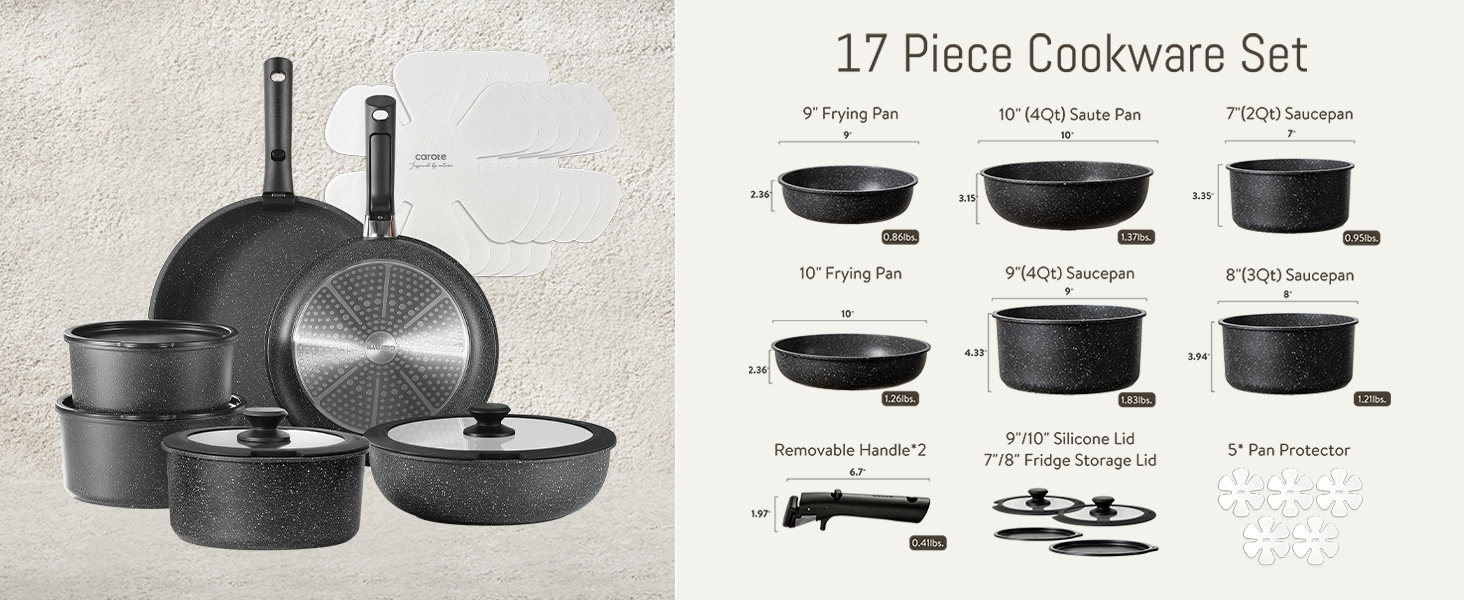
Pros:
- Space-Saving Design: The detachable handle system allows for easy stacking and storage, saving up to 70% more space—ideal for RVs, small kitchens, and camping setups.
- Versatile Use: Compatible with all stove types, oven safe, and can transition from stovetop to oven, grill, fridge, and table with a simple click.
- Easy Cleaning: Ultra non-stick granite coating makes cleanup quick and effortless, often requiring just a simple wipe or rinse.
- Even Heating: Reinforced die-cast aluminum ensures rapid and even heat distribution, minimizing hot spots and improving cooking results.
- Lightweight & Durable: Despite its robust construction, the set is lightweight and designed to withstand frequent use without warping or losing performance.
Cons:
- Hand Wash Only: Not dishwasher safe; requires hand washing to maintain the non-stick surface and extend the set’s lifespan.
- Handle Durability: Some users have reported issues with the handles breaking or wearing out over time, especially with frequent attachment and removal.
- Nonstick Longevity: The granite non-stick coating may be prone to scratching or peeling if metal utensils are used or if not properly cared for.
- Limited Reviews: As a relatively new product, there may be fewer long-term user experiences available compared to more established cookware brands.
- No Metal Utensils: Not suitable for use with metal utensils, which could damage the non-stick surface.
Editor’s Bottom Line:
The CAROTE 17pcs Pots and Pans Set stands out for its space-saving, versatile design and exceptional non-stick performance, making it a top choice for campers, RV owners, and anyone seeking convenience in compact kitchens.
While it requires gentle care and hand washing, its lightweight build, rapid heating, and ability to transition seamlessly from stove to oven to table make it a smart investment for those prioritizing efficiency and ease of use in their cooking routine.
Frequently Asked Questions
Q: Can I use regular kitchen cookware for camping?
Answer: Absolutely, you can use regular kitchen cookware for camping, but with a few caveats.
Most standard kitchen pots and pans will work just fine for basic car camping trips, especially if you're not hiking far or weight isn't a concern. For example, stainless steel or cast iron pans are durable and can handle open flames or camping stoves well. If you're just boiling water or heating soup, your usual saucepan will probably do the trick.
However, there are a few important things to keep in mind:
- Weight and Bulk: Regular kitchen cookware is often heavier and bulkier than gear designed for camping. If you're backpacking, this could be a dealbreaker. Camping cookware is typically lighter, more compact, and designed for easy packing.
- Damage Risk: Fancy non-stick pans or delicate glass lids might not survive the rough-and-tumble nature of camp life. Heat from open flames can also damage plastic handles or warp thinner pots.
- Cleanup: Camping often means limited water access. Non-stick coatings can make cleaning easier, but cheap non-stick surfaces may flake off under intense campfire heat. Look for cookware that’s easy to clean with minimal water.
- Versatility: Camping cookware often nests together, includes multi-use lids or doubles as bowls, and some even have heat-resistant handles that fold, making them more convenient than your standard kitchen gear.
If you're trying out camping for the first time, feel free to use what you have. Just be mindful of the heat source, handle with care, and pack responsibly. If you find yourself going often, investing in purpose-built camping cookware will pay off in the long run.
Q: How do I clean cookware without running water?
Answer: Cleaning cookware without running water is definitely possible—and even common for campers, hikers, or those in off-grid living situations. Here are some practical steps to keep your pots and pans clean when you're away from a sink:
1. Scrape Off Leftovers First
Use a spatula, spoon, or even a wad of paper towel to scrape off any leftover food or grease. Getting rid of as much residue as possible makes the rest of the process much easier.
2. Use Minimal Water Wisely
If you have a small supply of water, pour a little into the cookware and let it soak for a few minutes. This loosens up any stuck-on food. Then use a sponge or cloth to scrub. You can also use biodegradable soap if you’re outdoors (important to protect the environment).
3. Sand, Ash, or Dirt Scrub (for the outdoorsy folks)
If you don’t have soap, a bit of sand or clean ash from your campfire works surprisingly well as a natural abrasive. Just rub it gently with a cloth or your hand to lift grease and food particles. Be sure to rinse with a little clean water afterward.
4. Wipe Clean with a Cloth or Paper Towel
After scrubbing, wipe the cookware thoroughly with a clean cloth, towel, or napkin. If water is scarce, this step helps you remove the remaining grime.
5. Sanitize If Needed
If you're concerned about germs (especially after cooking meat), boil a small amount of water in the pan for a few minutes, or use sanitizing wipes. You can also briefly hold the metal cookware over a fire to kill bacteria—just be cautious.
Q: Is cast iron worth the weight for car camping?
Answer: Absolutely—cast iron’s heat retention excels at slow cooking and baking. Season properly and store in a breathable bag to prevent moisture buildup.
Q: What’s better: individual pieces or complete sets?
Answer: Sets like the Stanley Adventure provide cost-effective solutions with matched components. Experienced campers often mix specialty pieces (e.g., titanium pot + cast iron skillet).
Q: How do I prevent food from sticking without non-stick coatings?
Answer: Preventing food from sticking without relying on non-stick coatings is entirely possible with a few practical techniques and the right cookware. Here’s how you can do it:
Cast iron and carbon steel develop a natural non-stick layer over time when properly seasoned. Seasoning is the process of baking oil into the surface, creating a slick, protective layer. The more you cook with it (especially fatty foods), the better it gets.
2. Preheat the Pan Properly
A cold pan is more likely to cause sticking. Preheat your pan for a few minutes before adding oil or food. You can test it by sprinkling a few drops of water into the pan—if they dance or sizzle, it’s ready.
3. Add Oil at the Right Time
Once the pan is hot, add your oil and let it heat up before adding food. The oil fills microscopic gaps in the pan’s surface and creates a barrier between the food and the metal.
4. Don’t Crowd the Pan
Overcrowding lowers the temperature of the pan and creates steam, which leads to sticking. Give your food space to sear and release naturally.
5. Be Patient Before Flipping
Letting your food cook undisturbed helps it form a crust, which naturally releases from the pan. If it’s sticking, it’s usually not ready to flip yet—give it a few more seconds.
6. Use the Right Utensils
Using a metal spatula with a sharp edge (on cast iron or carbon steel) can help lift food without tearing it. For other pans, wooden or silicone tools work best.
7. Clean and Maintain Your Cookware
Avoid using soap on cast iron or carbon steel. Instead, wipe it out, scrub with salt if needed, and reapply a thin layer of oil. This keeps the seasoning intact.
By using these techniques, you can cook beautifully seared, golden-brown meals without synthetic non-stick coatings—just good old-fashioned culinary skill and care!
